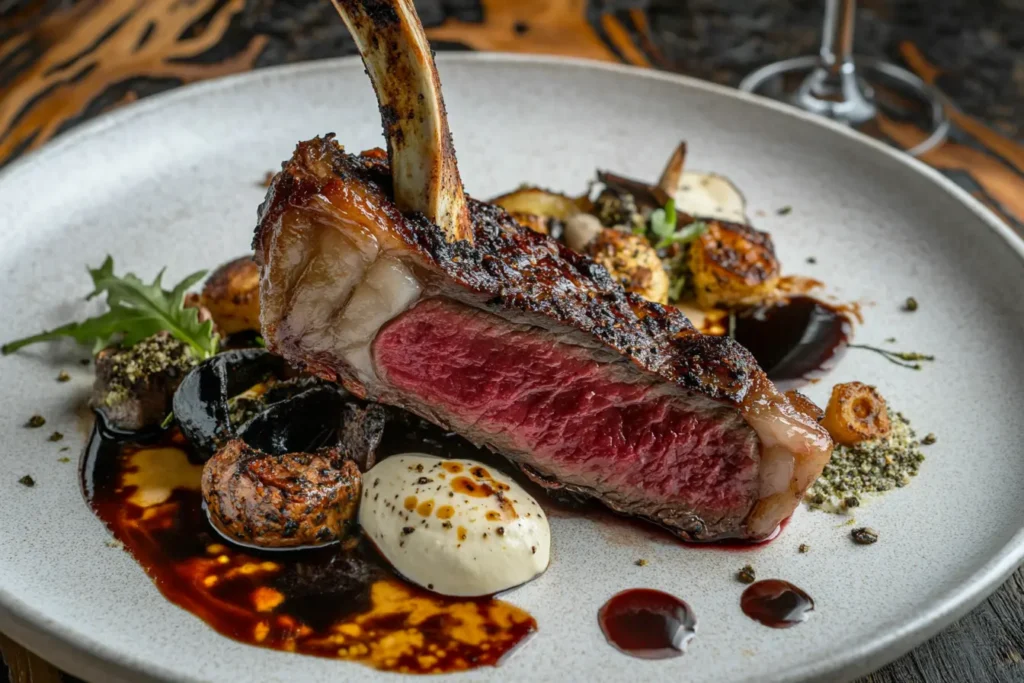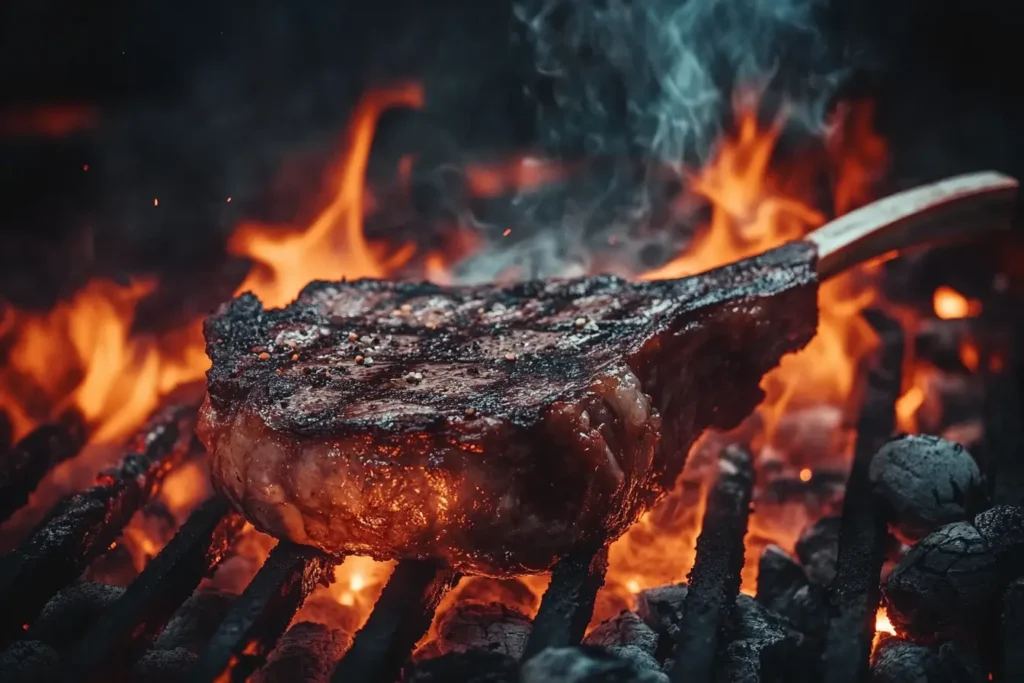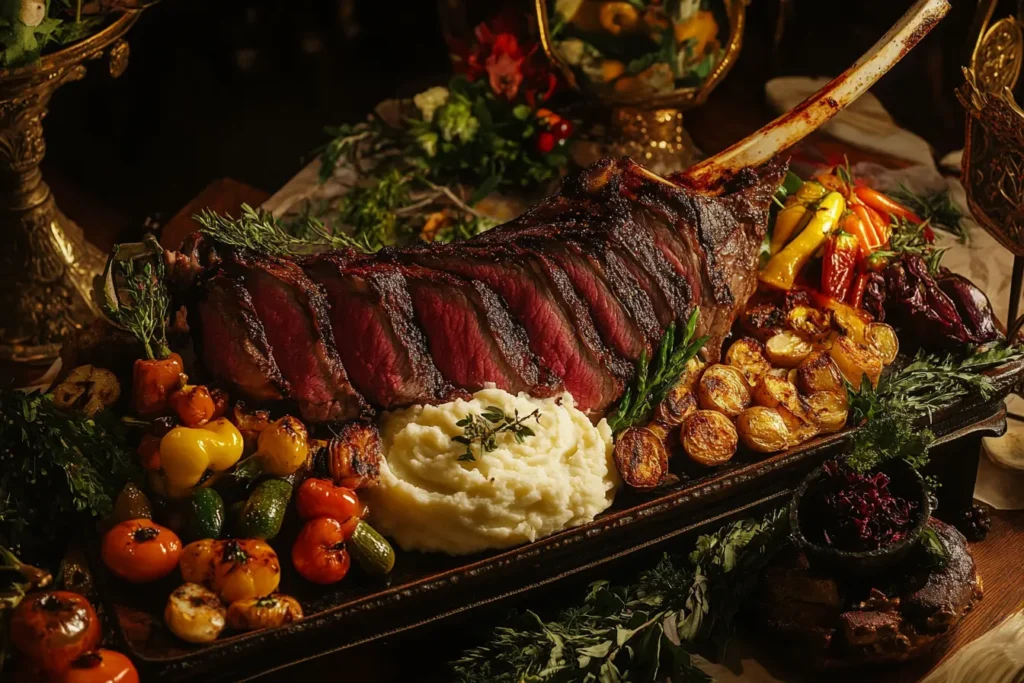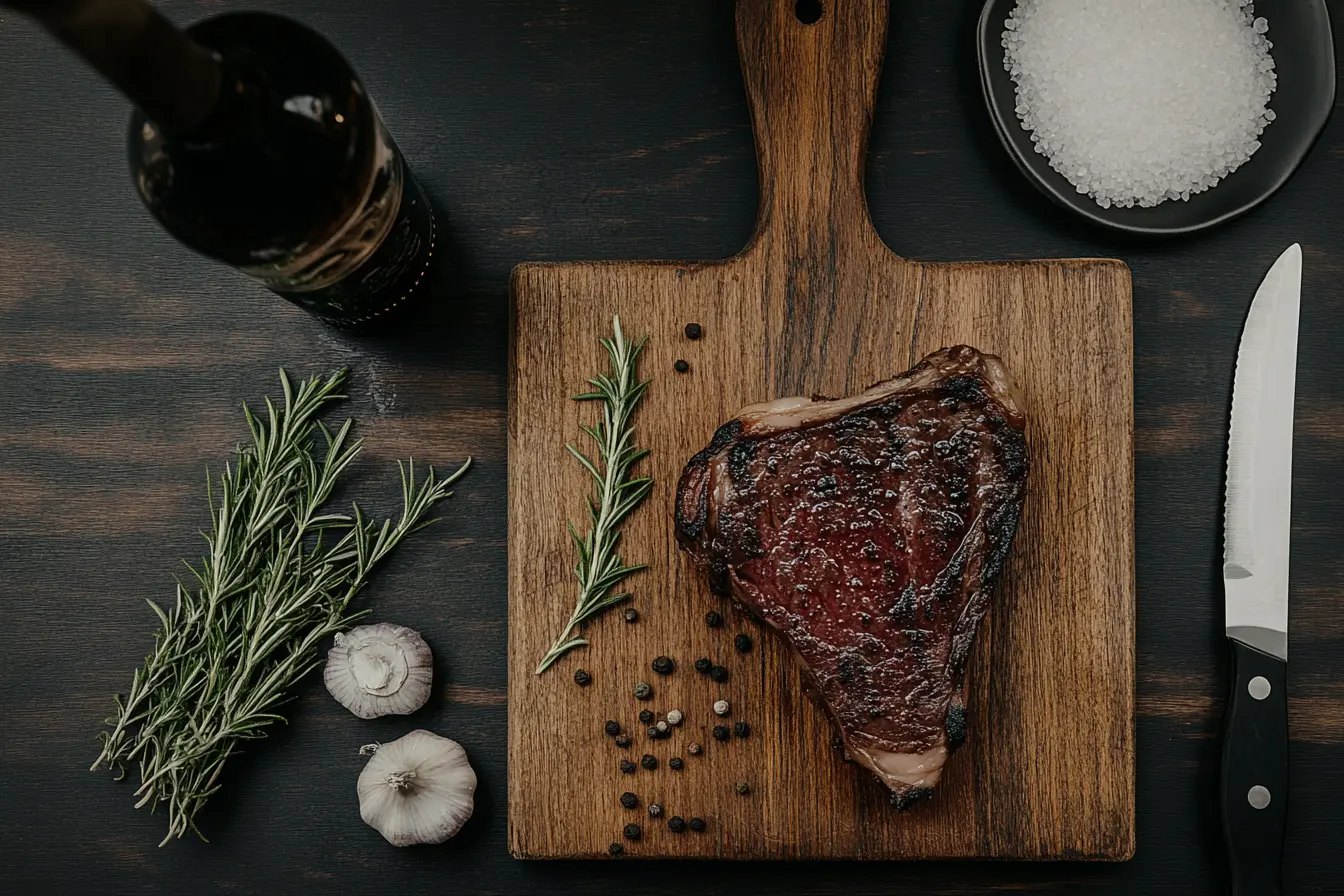Tomahawk steak is more than just a cut of meat; it’s an experience that captivates both the eyes and the taste buds. This guide will dive deep into its roots, highlight its distinguishing traits, and teach you how to prepare this culinary masterpiece. With each section, you’ll gain insights that elevate your steak game. Let’s jump right in and explore what makes the Tomahawk steak such a standout!
What is a Tomahawk Steak?
Definition
The Tomahawk steak is an extraordinary ribeye cut that grabs attention with its long Frenched bone. This feature isn’t just for show; it adds flavor during cooking and enhances its luxurious appeal. The meat’s rich marbling ensures every bite is juicy and tender, making it a go-to choice for special occasions.
Origin and History of Tomahawk Steak
The Tomahawk steak draws its lineage from the rib primal section of beef, known for producing some of the most flavorful cuts. Historically, Native American cultures and Australian ranchers helped popularize similar bone-in cuts, but modern chefs have elevated this steak into a global sensation. In recent years, it has become a staple at high-end restaurants, often synonymous with opulence and celebration.
Why is it Called Tomahawk Steak?
This steak is aptly named after the tomahawk axe, thanks to its bone-in design. The long, dramatic bone remains intact, creating a striking resemblance to the traditional tool. Interestingly, this visual appeal is a key reason why chefs and diners alike are drawn to it.
Popularity of Tomahawk Steak Worldwide
The worldwide appeal of Tomahawk lies in its unique combination of size, flavor, and presentation. It has found a place on menus across continents, from bustling New York steakhouses to serene countryside eateries in Europe. Its ability to serve as both a culinary and aesthetic highlight makes it irresistible to steak connoisseurs everywhere.
Characteristics of Tomahawk Steak
The Anatomy of Tomahawk Steak
Ribeye Cut with the Bone Intact
The Tomahawk steak features a ribeye cut with a long, Frenched bone attached, giving it its unique appearance. Butchers intentionally leave the bone intact to enhance its flavor during cooking. As heat penetrates the meat, the bone helps retain moisture and intensify the steak’s natural juiciness. This rib primal cut is renowned for its excellent marbling, which creates a tender, flavorful experience.
Differences Between Tomahawk and Other Steaks
The Tomahawk steak differs from other bone-in steaks because of its longer bone, which adds both flavor and dramatic presentation. While porterhouse and T-bone cuts also contain a bone, they lack the bold appearance and size that make the Tomahawk truly stand out. This steak pairs visual flair with a robust flavor that other cuts rarely match.
Unique Features of Tomahawk Steak
The Long Bone and Marbling
The defining feature of the Tomahawk steak is its long bone, which butchers carefully French to create a polished look. This bone isn’t just decorative—it also impacts the steak’s flavor by distributing heat evenly while it cooks. The marbling in the ribeye enhances the steak’s texture and creates a buttery richness that makes every bite satisfying. Together, these features make it a favorite for those seeking both taste and visual appeal.
Flavor Profile of Tomahawk Steak
The Tomahawk steak offers an extraordinary flavor that combines a rich, beefy essence with a subtle sweetness from its fat content. Cooking methods like grilling or pan-searing enhance this steak’s natural qualities, producing a golden-brown crust with tender meat inside. The marbled fat melts as the steak cooks, locking in moisture and ensuring that every bite is juicy and flavorful. A properly cooked Tomahawk delivers a bold and memorable dining experience.

Average Weight and Size
The Tomahawk steak is a showstopper, weighing between 2 to 3 pounds and measuring up to 10 inches long, thanks to its extended bone. Butchers deliberately leave the bone attached to elevate its visual impact and balance its massive size. Because of its substantial proportions, the Tomahawk is often shared, making it ideal for gatherings or special occasions where presentation matters as much as taste.
How to Cook Tomahawk Steak
Cooking a Tomahawk steak is an art, blending precision and patience to achieve the perfect balance of texture, flavor, and presentation. Whether you’re a seasoned chef or a home cook, following proper techniques will ensure this impressive cut becomes the star of your meal.
Preparation Techniques
Essential Ingredients and Tools Needed
Before cooking a Tomahawk steak, you’ll need a few key items. Start with high-quality ingredients like coarse salt, freshly ground black pepper, and olive oil for seasoning. For tools, a sturdy cast-iron skillet, a meat thermometer, and tongs are essential. If you’re grilling, ensure you have a clean grill grate and a reliable heat source. These tools and ingredients form the foundation for a flawless steak.
Steps to Prepare the Steak
Preparing a Tomahawk steak requires attention to detail. Begin by patting the steak dry with paper towels to remove excess moisture, which helps achieve a good sear. Generously season both sides with salt and pepper, ensuring the seasoning penetrates the meat. Let the steak rest at room temperature for about 30 minutes to allow even cooking. Meanwhile, preheat your skillet or grill to high heat, so it’s ready for searing.
Best Cooking Methods

Grilling
Grilling a Tomahawk steak is one of the most popular methods because it imparts a smoky flavor and creates a charred crust. Start by searing the steak over direct heat for 2-3 minutes per side to lock in juices. Then, move it to indirect heat, cover the grill, and cook until it reaches your desired internal temperature. Use a meat thermometer to ensure accuracy—125°F for medium-rare and 135°F for medium.
Pan-Searing and Oven Finishing
For indoor cooking, pan-searing combined with oven finishing works beautifully. Heat a cast-iron skillet over high heat and sear the steak for 2-3 minutes per side until a golden crust forms. Transfer the skillet to a preheated oven at 375°F and cook until it reaches the desired temperature. This method offers control over doneness and creates a crusty, caramelized exterior.
Sous Vide Method
The sous vide technique involves vacuum-sealing the steak and cooking it in a water bath at a precise temperature. After cooking, the steak is quickly seared in a hot pan to develop its crust. Sous vide ensures even cooking throughout, making it a great option for achieving consistent results with minimal effort.
Tips for Cooking the Perfect Tomahawk Steak
- Always let the steak rest for 5-10 minutes after cooking to redistribute juices.
- Use a meat thermometer to monitor doneness accurately.
- Don’t overcrowd the grill or skillet, as this can reduce heat and affect the sear.
Common Mistakes to Avoid
Avoid overcooking, which dries out the meat and diminishes its flavor. Similarly, under-seasoning can leave the steak bland, so be generous with salt and pepper. Finally, skipping the resting period after cooking can cause juices to escape when slicing, reducing its tenderness.
Serving and Pairing Suggestions
Once your Tomahawk steak is perfectly cooked, the next step is serving it in a way that highlights its impressive size and flavor. Pairing it with complementary side dishes and beverages elevates the meal, turning it into a memorable experience.
How to Serve Tomahawk Steak
Presentation is key when serving a Tomahawk steak. Start by letting the steak rest for 5-10 minutes after cooking to allow the juices to redistribute. Place the steak on a large cutting board or serving platter for carving. Use a sharp knife to slice the meat perpendicular to the bone into even portions, ensuring each slice has a bit of the flavorful crust and tender interior. For added flair, keep the long bone intact on the serving platter, creating a dramatic centerpiece for your table.

Best Side Dishes
Pairing the Tomahawk steak with the right sides enhances its flavor and creates a balanced meal. Here are a few options that complement its richness:
- Mashed Potatoes: Creamy mashed potatoes provide a comforting, starchy contrast to the steak’s bold flavor.
- Grilled Vegetables: Asparagus, zucchini, or bell peppers add a pop of color and a touch of smokiness.
- Roasted Garlic: The mellow sweetness of roasted garlic pairs beautifully with the steak’s savory notes.
- Fresh Salads: A crisp green salad with a light vinaigrette offers a refreshing counterpoint to the richness of the meat.
To make your presentation even more impressive, arrange the sides around the steak for a visually stunning display.
Beverage Pairings
For non-alcoholic options, consider beverages that balance the steak’s richness:
- Sparkling Water with Citrus: The effervescence cleanses the palate between bites.
- Iced Tea: The subtle sweetness and astringency of tea pair well with grilled meats.
- Fruit Juices: Pomegranate or cranberry juice provides a tart, refreshing contrast.
These drinks enhance the dining experience without overshadowing the steak’s robust flavor.
FAQs
The cost of a Tomahawk steak comes down to its size, quality, and presentation. This cut is sourced from the rib primal, which is among the most premium sections of the cow. Additionally, the meticulous process of Frenching the bone adds labor, contributing to its higher price. Its dramatic appearance also makes it a popular choice for fine dining, further elevating its perceived value.
While a Tomahawk steak is technically a ribeye, the attached long bone sets it apart. The bone adds visual appeal and enhances the flavor during cooking, thanks to its ability to retain heat. In contrast, a traditional ribeye is often trimmed and smaller, lacking the Tomahawk’s signature presentation.
To store a Tomahawk steak, wrap it tightly in plastic wrap or butcher paper and place it in the refrigerator. For short-term storage, it will remain fresh for up to 3-5 days. If you need to store it longer, freezing is the best option. Vacuum-sealing the steak before freezing prevents freezer burn and maintains its quality for several months.
Yes, the Tomahawk steak can be cooked in the oven and delivers excellent results. Start by searing it in a hot skillet to develop a crust, then transfer it to a preheated oven. Cook at 375°F until the steak reaches your desired internal temperature. This method ensures even cooking while preserving its juicy texture.
The Tomahawk steak offers a good source of protein and essential nutrients like iron and zinc. However, its higher fat content, due to the marbling, means it’s best enjoyed in moderation. Pairing it with fresh vegetables and lighter sides can balance the meal and enhance its nutritional value.

